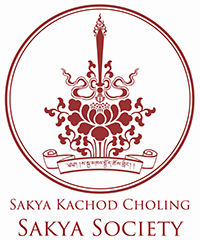
The Five Founders of the Sakya Order. center: Sachen Kunga Nyingpo; top left: Sonam Tsemo; top right: Drakpa Gyaltsen; lower left: Sakya Pandita; lower right: Chogyal Phagpa
Sakya is one of the main traditions of Tibetan Buddhism.
The Sakya tradition takes its name from the monastery founded in 1073 at Sakya (which literally means “the place of pale earth”) in south-western Tibet by Konchok Gyalpo, a member of the Khon family. This influential family had been practicing the Nyingma (old) school. But with the introduction of new tantras to Tibet in the eleventh century, Konchok Gyalpo studied the theories and methods and founded the Sakya tradition. The most important of the teachings which he received from his teacher Drokmi Lotsawa, a disciple of the Indian scholar Gayadhara, was the meditational system known as the Path with Its Result (Tib. Lamdre), systematized by the Mahasiddha Virupa.
In the twelfth and thirteenth centuries, the Sakya tradition rose to a position of prominence in the religious and cultural life of Tibet. This was due largely to the endeavors of the five great masters: Sachen Kunga Nyingpo (1092-1158); Lopon Sonam Tsemo (1142-1182); Jetsun Drakpa Gyaltsen (1147-1216); Choje Sakya Pandita (1182-1251); and Drogon Chogyal Phakpa (1235-1280). Since that time, the Sakya tradition and its branch schools—the Ngor, founded by Ngorchen Kunga Zangpo (1382-1457); the Tsar, founded by Tsarchen Losel Gyatso (1502-1556); and subsequently the Dzongpa, founded by Dorje Denpa Kunga Namgyal (1432-1496) —have been adorned by the holy works and spiritual blessings of numerous illustrious yogis and scholars. It became known for its even emphasis on study and meditation.
Now the Sakya tradition, under the compassionate guidance of His Holiness the Sakya Trichen (b. 1945), has spread throughout the world.

